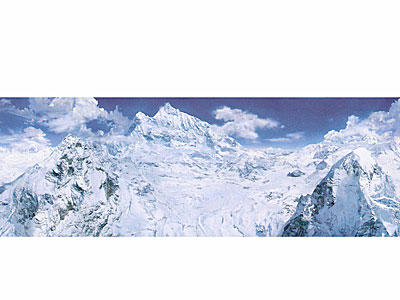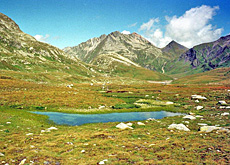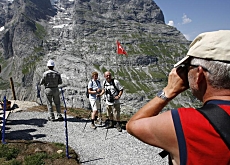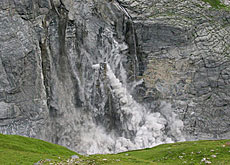Alps shown to be the summit of perfection

The human fascination with the Alps is the subject of a new exhibition at Zurich's fine arts museum, the Kunsthaus.
More than 300 works from artists, scientists and explorers aim to show how the majestic mountain chain has inspired – and awed – people over the centuries.
“In the Alps”, which runs until January, presents imagery of the Alpine world from the 17th century to the present day.
The items include cartographic models, early tourist photographs and posters. Works by prominent amateur painters such as Winston Churchill are exhibited along side such greats as the British artist William Turner and Swiss painter Ferdinand Hodler.
The exhibition aims to provide a wide-ranging look into the Alps – which stretch 1,200 kilometres from France to Slovenia – and is not just focused on its renowned mountains.
“The history and the perception of the mountain chain that lies at the heart of Europe goes a lot further than the usual clichés,” Catherine Hug, one of the curators of the exhibition, told swissinfo.
The display therefore starts with a somewhat startling vision of the Alps, which are presented as looking almost like a barren lunar landscape where there is no human activity.
“Before mountaineering was born at the beginning of the 18th century, people used to be afraid of our mountain peaks. They thought they were impassable and did not dare defy them because they considered them the image of divine will,” explained Hug.
Changing view
This mystical view persisted for many centuries. But over time people became interested in other, more scientific, aspects such as Alpine flora and fauna.
One of the finest examples of this is a 17th century book by Konrad Gessner on mountain birds – the oldest item in the exhibition.
A large part of the display is devoted to artists’ visions of the Alps. The “alpine glow”, a natural phenomenon in the Alps at dusk where red gleam of the setting sun is reflected off slopes or snowfields, has been captured by several painters.
Another favourite subject is life in the Alps, from the ubiquitous Heidi and Matterhorn images to those of native costumes and folk events such as the Unspunnen festival near the Bernese Oberland resort of Interlaken.
The more clinical approach of scientists, geologists and cartographers also features in the exhibition, with examples of their painstaking work mapping out the mountains and finding ways through them.
The role of the Alps in defence is also considered. “The mountain [is seen] as a fortress, source of protection against the invader, of closing into itself,” said Hug, underlining the role of the mountains in Switzerland’s defence strategy during the Second World War.
“At the same time, however, the Alps are becoming a place that links north and south Europe,” added the curator. This can be seen in Thomas Schuttel’s sculpture of a tunnel carved through a mountain.
Tourism
There is also a section devoted to the all important Alpine industry of tourism. It shows how the birth of mountaineering in the 18th century greatly helped the local economy and gave the Alps international renown.
However, not all tourism was positive. A painting by Charles Hamilton Smith depicts the terrible landslide of 1806 which destroyed the village of Arth-Goldau, killing more than 400 people. Tourists are shown to be looking at the site in a very early example of “disaster tourism”.
Current tourism trends from hiking to “wellness” holidays to recuperate from the stresses and strains of everyday life are detailed in a series of posters.
“The Alpine region has been described as a paradise on earth,” says Hug – and as the exhibition shows, the Alps’ legendary reputation lives on.
swissinfo
“In the Alps” runs until January 2, 2007 at Zurich’s fine arts museum, the Kunsthaus.
It contains more than 300 works from 138 artists from the 17th century to the present day.
Opening hours: Tuesday-Thursday 10 am-9 pm, Friday-Sunday 10am-5pm. Mondays closed.
The Alps are the oldest and most impressive mountain chain in Europe. They stretch over 1,200 km and cover a surface of 300,000km².
The highest peak is Mont Blanc in France at 4,819 m. It is often called the roof of Europe.
The Alps are situated in the heart of Europe and run across 8 countries: Switzerland, Austria, Germany, Liechtenstein, France, Monaco, Italy and Slovenia.

In compliance with the JTI standards
More: SWI swissinfo.ch certified by the Journalism Trust Initiative




You can find an overview of ongoing debates with our journalists here . Please join us!
If you want to start a conversation about a topic raised in this article or want to report factual errors, email us at english@swissinfo.ch.